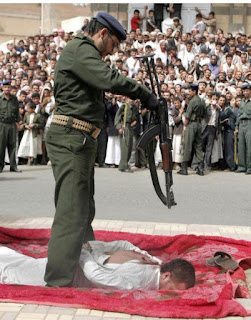The Execution of a Child Rapist in Yemen: A Public Spectacle and Its Implications
In a dramatic and controversial display of justice, Yemen executed a man convicted of raping and murdering a three-year-old girl in the capital city of Sanaa. The public execution, which took place in front of hundreds of onlookers, marks the first such event in Yemen since 2009. This incident has sparked a widespread debate about the morality and effectiveness of public executions, the state of the judicial system in Yemen, and the broader implications for human rights.
The Crime and Conviction
The case that led to the execution involved a heinous crime: the rape and murder of a three-year-old girl. The details of the crime were shocking and stirred outrage across the nation. The man, whose name was not widely publicized, was swiftly arrested, tried, and convicted in a legal process that many argue reflects the severe and direct nature of Yemeni justice, particularly for crimes against children.
In Yemen, crimes of this nature are considered among the most egregious, warranting the harshest punishments. The legal framework in Yemen allows for capital punishment, and public executions are seen as a means to demonstrate the state’s commitment to justice and deterrence. However, such practices are fraught with ethical concerns and criticisms, both domestically and internationally.
The Execution
The execution took place in Tahrir Square, a central location in Sanaa, known for its historical and political significance. The convicted man was handcuffed, forced to lie face down, and then shot by a police officer in front of a crowd that included men, women, and even children. The execution was carried out with a precision intended to convey both the finality of justice and the seriousness of the crime.
The spectacle drew a large number of onlookers, some of whom captured the event on their phones, disseminating images and videos across social media. The public nature of the execution was intended as a stark warning to potential offenders, reinforcing the state's zero-tolerance policy towards such crimes. For many in the crowd, the execution was a moment of catharsis, a visible and immediate form of retribution for an unspeakable crime.
Public Reactions
Public reaction to the execution has been mixed. On one hand, many Yemenis expressed support for the execution, viewing it as a necessary and just response to a brutal crime. In a country plagued by violence, war, and a failing judicial system, such public acts of justice are sometimes seen as necessary to maintain order and deter future crimes.
On the other hand, human rights activists and international organizations have condemned the execution. Amnesty International and Human Rights Watch have criticized Yemen's use of the death penalty and the manner in which it was carried out. They argue that public executions violate basic human rights and dignity, regardless of the crime committed. Furthermore, they raise concerns about the fairness of the judicial process in Yemen, where due process and fair trials are often compromised by political and social pressures.
Broader Implications
The public execution in Sanaa highlights several broader issues within Yemen and beyond. Firstly, it underscores the dire state of the Yemeni judicial system. Yemen has been mired in conflict since 2014, with various factions vying for control, leading to a breakdown in law and order. In such an environment, swift and severe justice is sometimes seen as the only way to maintain a semblance of control and deter criminal activity.
Secondly, the execution brings to light the cultural and societal attitudes towards crime and punishment in Yemen. Public executions are deeply rooted in the country’s legal traditions and are seen by some as an effective deterrent. However, these practices are increasingly at odds with international human rights norms and the global movement towards the abolition of the death penalty.
Lastly, the execution raises ethical questions about the nature of justice. While the crime was undoubtedly horrific, the manner of the execution—public, brutal, and final—poses a moral dilemma. Does such a method of punishment truly serve justice, or does it merely perpetuate a cycle of violence and retribution? Can a society claim to uphold human dignity and rights while publicly executing individuals, regardless of their crimes?
Conclusion
The public execution of a man convicted of raping and murdering a child in Sanaa is a stark reminder of the complexities and contradictions inherent in issues of justice and human rights. While it may serve as a deterrent and provide a sense of justice to a grieving community, it also exposes the deep ethical and human rights concerns associated with capital punishment.
As Yemen continues to navigate its myriad challenges, the global community must grapple with these difficult questions, advocating for a system of justice that upholds human dignity, ensures fair trials, and moves away from the practices of public executions. The case serves as a potent symbol of the ongoing struggle between maintaining order and upholding the principles of human rights, a balance that remains elusive in many parts of the world.




Comments
Post a Comment